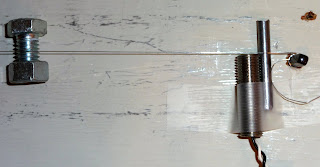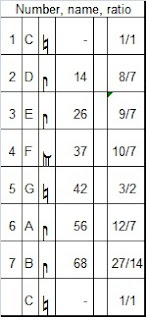This is a work in progress. So there will be frequent updates.
Play it here
or download this link
This is a work in progress. So there will be frequent updates.
Play it here
or download this link
This is a work in progress. It’s much longer than any of my usual incomplete works. But that’s because it steps through a lot of different modes of a scale. The scale used is based on the overtone series for the most part, but the tonic is the 7/4. Here’s a picture of it.
I created several modes from the scale based on 4ths chords. For example, it starts in the mode with the 1st, 3rd, 5th, 7th, 8th, and Ath degree of the scale. These represent the ratios of 1:1 8:7 9:7 3:2 12:7 27:14 2:1. These can also be described as 14:14 16:14 18:14 21:14 24:14 27:14 and 28:14. I then pile them up to make a pair of fourth cords, A 5 8 and 3 7 1. I like fourths. I found eight modes from the 10 note scale, and assembled them into a list. I then step through them one at a time for about 45 seconds each. Once with a melody, then without, then variations on the melody. I have a lot more work to do on this, but it has a nice movement as it steps through the modes that are more jagged and unequal in step sizes to those that are very pentatonic. The first one is rather pentatonic.
Here are the rest:
It’s scored at the moment just for violin, viola, cello, long strings, and finger piano, but I plan to add some percussion. It doesn’t have a beginning or an end yet. But I’ll get there soon enough.
or download this link
The 15th pass through the algorithm was pretty nice also. Have to make a choice soon. Play it here
or download this link
This one is done for now. It’s based on a scale I used on my 12 note finger piano:
It has a very large 1st and 5th steps: 8:7, and two very small steps: 10:7 to 21:14 is only 21:20, and the step from 27:14 to 28:14 is only 28:27. It makes for some nice melodic passages, and trills can vary from as small as 28:27 to 8:7. Lots of variety is available. These are the only 7 pitches in the piece – I don’t modulate to any other key but C. The slides of course hit other tones, but the start and end tones are all one of those seven pitches. If someone recognizes the scale, let me know so I can give credit to the inventor.
The instrumentation is Alto Flute, finger piano bass, long and short .024″ music wire strings with the pickup as close as possible to the bridge, oboe, balloon drums, and tube drums.
As with all my music, there is a great deal of indeterminacy. Each instrument has lots of choices about what it will play at each moment, based on different randomization algorithms. Sometimes it tries to repeat itself, and sometimes it tries to chose something it hasn’t chosen lately. The format starts with a bridge, then a melody, then variations. It repeats that structure four times.
Here’s a picture of the bench I used to make the long string samples. The longest is about 18 feet long, and the shortest just a few inches for the very high notes. The location is a wall in my office made of a glulam beam composed of six four by sixes laminated together. It’s very solid and helps the samples sustain so long (up to 20 seconds for the long ones.) The less the instrument vibrates, the longer the sustain.
or download this link
This is a work in progress.
I made some new string samples, this time using a more solid base and bridge setup, so that the notes sounded better. Here’s a picture of the end of the bench. 
On the far right is the zither tuning pin (from Bart Hopkin’s Experimental Musical Instruments online store.) Then a small metal rod as the bridge on one end, and next the magnetic transducer. Notice how close to the bridge it’s located. This gives the strings more of a harpsichord sound than guitar. The left end of the picture is the movable bridge. In this picture it’s a very short string, making a very high note. The longest ones are around 15′. Notice also the rugged method which which the transducer is mounted: scotch tape. It only has to last a few minutes while I record the samples.
Then it’s on to CoolEdit to crop and tune the samples:
On the CoolEdit screen you can see the waveform of the string in green on the right. This is the first part of a sample at D#7 22 cents flat. That’s a very high note. I try to edit out any silence from the start of the note so that the attack happens when I expect it. Csound adjusts the pitch by moving it up 22 cents during sound generation.
Here’s how it sounds in a the Serenade I’ve been working on:
or download this link
This is a work in progress.
I’m working on the bed for the flute solo. It’s vamp that the flute will play against. Today I added guitar trills. It was challenging to get them right. I’ll have to reduce the bass finger piano volume soon. There are a set of changes I anticipate making on my flight home to Seattle tomorrow night. Let’s see what that produces. Play it here
or download this link
This is a work in progress.
Today I was able to work on the variations of the theme. Dotted eighth and sixteenth or two eighth notes. I plan more variations, but that’s a start. I’m really digging the long string parts. I’ve built a new jig at home to make more long string samples. I already have samples that go from G0 to B0, but then they skip all the way up to G3. This means that when Csound looks for a sample to play, it has to use one that was far lower than the called for note. Best practices says that samples should not be more than a whole tone away from their original note. I planned to close that gap today, but was called to a customer meeting in Portland. I can’t wait to see what the gap filling produces.Play it here
or download this link
This is a work in progress.
Today’s entry is the start of a piece on a tuning that I used to use on one of my finger pianos. It’s a subset of the tonality diamond, just 12 notes per octave. Here’s a picture of the tuning, based on the overtones of C and F.
I always liked a mode based on the 7:6 and 7:4. They are a 3:2 apart, and make a nice bass drone. The chords above are a bit strange, but attractive in their own way. I shifted the mode down a 7:6, so that the tonic was on c. Here’s a picture of that:
The number on the right column is the scale degree. The next column is the note name, the Sagittal accidental, then the 72-EDO number, and the ratio. Notice that the 2nd degree of the scale is a huge 8:7. Makes a big jump on that first step.
This version is scored for alto flute, finger piano, long strings, and oboes. It’s just a start for now.
or download this link
This is a work in progress.
Today’s entry is the start of a piece on a tuning that I used to use on one of my finger pianos. It’s a subset of the tonality diamond, just 12 notes per octave. Here’s a picture of the tuning, based on the overtones of C and F.
I always liked a mode based on the 7:6 and 7:4. They are a 3:2 apart, and make a nice bass drone. The chords above are a bit strange, but attractive in their own way. I shifted the mode down a 7:6, so that the tonic was on c. Here’s a picture of that:
The number on the right column is the scale degree. The next column is the note name, the Sagittal accidental, then the 72-EDO number, and the ratio. Notice that the 2nd degree of the scale is a huge 8:7. Makes a big jump on that first step.
This version is scored for alto flute, finger piano, long strings, and oboes. It’s just a start for now.
or download this link
I think this is the final take on this piece. I added some more variety in the theme and the bridge, and more variations. There is one point towards the end when it repeats a time or two too many times, but this take it at least repeats something interesting. There are lots of string chords that glide from one chord to another, like a pedal steel guitar might do. And the bass spring is more defined here.
or download this link